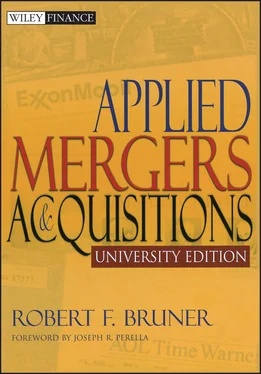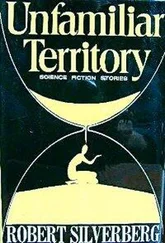*Significant at the 0.99 level or better.
†Significant at the 0.90 level.
‡Significant at the 0.95 level.
EXHIBIT 6.19 Summary of Studies of Market Returns to Parent Shareholders at Creation of Tracking Stocks
| Study |
Cumulative Abnormal Returns at the Event |
Cumulative Abnormal Returns after the Event |
Sample Size |
Sample Period |
| Haushalter, Mikkelson (2001) |
+3.00% *full sample (days –2,+2) |
|
31 |
1994–1996 |
| Billet, Vijh (2000) |
+2.67% * |
Parent company1.07% (1 yr.) –5.77% (2 yrs.) –4.15% (3 yrs.) Tracking stock +9.74% (1 yr.) –15.26% (2 yrs.) —40.05% †(3 yrs.) |
20 |
1984–1998 |
| Elder, Westra (2000) |
+3.1% *full sample (days –1,0) |
N/A |
35 |
1984–1999 |
| D’Souza, Jacob (1999) |
+3.61% *full sample (days –1,+1) |
|
64 |
1984–1997 |
| Logue, Seward, Walsh (1996) |
+2.9% †(days –1,0) |
N/A |
8 |
1985–1994 |
| Chemmanur, Paeglis (2001) |
+3.09% *(days –1,+1) |
|
19 |
1984–1998 |
Unless otherwise noted, event date is announcement date of transaction.
*Significant at the 0.99 level or better.
†Significant at the 0.95 level.
Fourth, the types of transactions do differ in their effects. Though the diagrams in Exhibit 6.14suggest a strong similarity in their resulting structures, in fact the transaction types have materially different impacts: Tracking stocks do not result in increased focus, tax, or regulatory benefits, only increased transparency. Split-offs alter the ownership of the parent; carve-outs, like divestitures, change the ownership of the subsidiary. In a spin-off, no new funds flow to the parent—Anderson (2002) finds that the need to raise additional capital is significant in explaining the type of transaction chosen. Parrino (1997) documents a major transfer of wealth from bondholders to stockholders from a spin-off effected by Marriott Corporation. The variation in returns across transaction type could be explained by any of these factors: agency costs, internal capital markets, information, control, and so on. Notwithstanding the differences among the forms of these transactions, abnormal returns from these transactions are generally consistent: spin-offs return roughly 2 to 4 percent, compared to carve-outs of 2 to 3 percent, and tracking stocks of 3 percent.
Fifth, as with divestitures, deployment of funds raised in these transactions makes a difference. Allen and McConnell (1998) found a large difference in announcement day returns: Investors reacted positively to carve-outs that would generate cash to be paid to creditors; instances where the funds were to be reinvested in the business were met with zero response from investors.
Sixth, the restructuring has an impact on the rivals of the firm. Hurlburt et al. (2002) found that the effect of carve-out announcements on the returns of rival firms was significantly negative.
Seventh, the timing and type of the restructuring seems to be associated with the valuation of the parent and subsidiary in the capital markets. Nanda (1991) suggests that opportunistic behavior by managers will motivate them to favor carve-outs over divestitures when the parent’s shares are relatively undervalued and the subsidiary’s shares are relatively overvalued. Thus, a sale of equity in the subsidiary would become a signal to investors of the parent’s undervaluation. The findings on carve-out announcement returns in Exhibit 6.18generally support such a hypothesis. For instance, Schill and Zhou (2001) write, “Overall, the evidence can best be explained with models where clienteles of investors with optimistically biased expectations drive the prices of subsidiaries above parent valuations and arbitrage costs prohibit market forces from eliminating the disparity between parent-subsidiary valuations.” (Page 27)
The hypotheses about the sources of gains from restructuring center predominantly on two: an agency cost argument that increased focus cures ills of internal capital markets; and hypotheses about exploiting misvaluations in the market. These hypotheses are not mutually exclusive. But the research supports the existence of both sources, giving, perhaps, more weight to the agency cost hypothesis on the grounds of the number of studies confirming the value of corporate focus.
FRAMEWORK FOR CHOOSING A PATH FOR INORGANIC GROWTH
The wide range of possible instruments for inorganic growth easily bewilders the senior executive. Yet the advantages and disadvantages of each alternative raise a number of considerations that can help the executive sort out the alternatives. These considerations help form a decision path:
1 Benefits from a relationship: learning and coordination gains. If one of the strategic objectives is knowledge transfer from the partner to your firm, a closer engagement would be warranted. Some targets of inorganic growth programs may be highly related to the main business activities of the buyer. In these instances, the demands of close integration necessary to realize benefits may dictate closer business ties. But other targets may have a weaker relationship to the core and thus may not require close ties.
2 Need for ownership and control. Control would be a priority in cases where the intentions of the partner are unclear and there is a risk that the partner will defect to a competitor, or worse, become a competitor. High control might also be dictated where the partner holds assets of strategic value to your firm, which would create a disadvantage if they fell into a competitor’s hands. In many cases, total ownership is not required. Partial ownership may deliver a place on the board of directors and a say in management. But in other cases, simply doing business through a contractual agreement (i.e., with no ownership) may be sufficient to deliver the strategic needs.
3 Manage risk exposure. The risks of some target operations will be well known to the buyer, appear to be manageable, and may be at an acceptable level. But for other targets, the risks will be uncertain, unmanageable, and potentially large—in these cases it may be desirable to isolate the target with legal “firewalls” that will contain the risk exposure to your firm. Another aspect of managing risk is in being able to intervene in the operations and financing of a weak partner with know-how and funds. As detailed in Chapter 19, a variety of acquisition structures permit the management of risks in a target. Nevertheless, the limited liability of minority investment or joint venture permits your firm to acquire a stake in the expansion business pending the resolution of uncertainty. Staged investing through these intermediate structures is a time-honored way to deal with uncertainty.
These three criteria convey the complexity of the choice. One could compound the complexity further with considerations of the desirability of a local identity (as in cross-border expansions) and size of the deal (i.e., large transaction costs for lawyers, due diligence, and financial advice may not be warranted for small transactions).
These considerations suggest a decision flowchart such as presented in Exhibit 6.20. First, one confronts the strategic perspective: How material are the benefits from a relationship in the expansion opportunity? Next is the need for control: Is this high or low? The third regards the risk exposure in the opportunity, and the possible need to isolate the risks: Are the risks and the need to isolate them high? Will the expansion opportunity need our capital? Is it financially weak? Tracing the branches of this decision tree over to the right-hand side one sees the array of transaction alternatives from merger or acquisition at the top extreme, to a simple contractual arrangement at the bottom. This tree was built from just these three considerations. Other considerations may dominate the thinking of senior executives, or they may bear influence in a different order of priority. But this decision tree is sufficient to illustrate a few conclusions about the choice among inorganic growth alternatives:
Читать дальше












